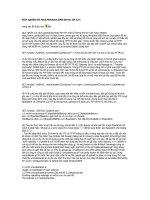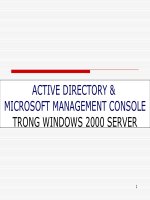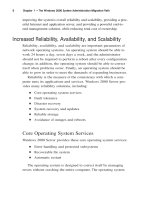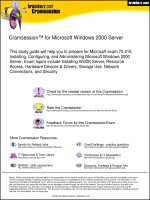Windows 2000 Server System Administration Handbook P2
Bạn đang xem bản rút gọn của tài liệu. Xem và tải ngay bản đầy đủ của tài liệu tại đây (61.48 KB, 20 trang )
6 Chapter 1 • The Windows 2000 System Administration Migration Path
improving the system’s overall reliability and scalability, providing a pow-
erful Internet and application server, and providing a powerful end-to-
end management solution, while reducing total cost of ownership.
Increased Reliability, Availability, and Scalability
Reliability, availability, and scalability are important parameters of
network operating systems. An operating system should be able to
work 24 hours a day, seven days a week, and the administrator
should not be required to perform a reboot after every configuration
change; in addition, the operating system should be able to correct
itself when problems occur. Finally, an operating system should be
able to grow in order to meet the demands of expanding businesses.
Reliability is the measure of the consistency with which a com-
puter runs its applications and services. Windows 2000 Server pro-
vides many reliability solutions, including:
■
Core operating system services
■
Fault tolerance
■
Disaster recovery
■
System recovery and updates
■
Reliable storage
■
Avoidance of outages and reboots
Core Operating System Services
Windows 2000 Server provides these core operating system services:
■
Error handling and protected subsystems
■
Recoverable file system
■
Automatic restart
The operating system is designed to correct itself by managing
errors without crashing the entire computer. The operating system
74_sysad_01.qx 11/8/99 9:18 AM Page 6
The Windows 2000 System Administration Migration Path • Chapter 1 7
ensures that a fault in one program will not affect other running
programs, by using protected subsystems that isolate programs in
memory.
Windows 2000’s new NTFS 5.0 file system logs all disk I/O oper-
ations as individual, unique transactions, so the system provides
fault tolerance by undoing or redoing transactions after a system is
brought back up after having suffered a disk failure.
It is to be hoped that your system will never have to restart itself
after a system failure; however, if a failure does occur, Windows
2000 Server can be set to restart itself automatically. This capability
is important if no administrators are present when the system
crashes. Because many servers have enormous amounts of RAM,
dumping the contents of RAM could take quite a while, thus
increasing downtime. Fortunately, Windows 2000 is designed to
restart more quickly than it was able to do in earlier versions,
thanks to a new “Write kernel information only” dump option.
Fault Tolerance
Windows 2000 Server increases fault tolerance by providing:
■
Support for various RAID levels
■
Distributed file system (Dfs)
Windows 2000 supports the various levels of RAID that adminis-
trators may require; it includes support for disk mirroring or disk
duplexing (RAID level 1), and disk striping with parity (RAID level 5).
Windows 2000 Server also supports RAID level 0, which is striping
without Parity; however, this offers no data redundancy.
Another feature, the Distributed file system, improves fault toler-
ance by providing increased data availability and load balancing
when it is integrated with Active Directory. Dfs makes finding and
managing information much easier by implementing a single name-
space for miscellaneous file system resources, which allows shares
to be maintained redundantly among multiple servers.
74_sysad_01.qx 11/8/99 9:18 AM Page 7
8 Chapter 1 • The Windows 2000 System Administration Migration Path
Disaster and System Recovery
Windows 2000 Server provides methods for disaster and system
recovery:
■
Tape backup and UPS support
■
Repair Command Console
■
Safe mode boot
■
System File Protection
Windows 2000 includes an enhanced and powerful tape backup
utility, and also includes support for uninterruptible power supplies
through a UPS service, which sends alerts in the event of a power
failure. In addition, the service is capable of safely shutting down
the system before the battery power in the power supply is depleted.
Another useful utility allows access to the NTFS file system for
authorized users in case the server becomes inaccessible. Using the
boot floppies, you can access this utility, called the Repair
Command Console. Before Windows 2000, many administrators
would resort to installing a parallel copy of Windows NT into a dif-
ferent directory in order to gain access to the files system. The other
option was to install NT on a FAT partition so access could be
gained to the file system through the use of a Windows 98 boot
disk. Fortunately, the Windows 2000 Repair Command Console pro-
vides an alternate way to safely and efficiently gain access to the file
system.
Windows 2000 Server incorporates great features from operating
systems such as Windows 98, by allowing a computer to be started
in Safe mode. Often a computer will not start because of a bad or
misconfigured driver. In the past, administrators often relied upon
the “Last known good configuration” menu selection; however, this
did not always work. With the ability to boot into Safe mode, the
system can be started with the minimal number of drivers loaded,
which allows you to make modifications or remove the faulty driver.
Windows 2000 also avoids file version mismatches, through the
System File Protection (SFP) system. SFP monitors protected files
74_sysad_01.qx 11/8/99 9:18 AM Page 8
The Windows 2000 System Administration Migration Path • Chapter 1 9
and keeps a cache of original system files in case it becomes neces-
sary to restore one of them. SFP tracks the proper file versions and
stores this information in catalogs with a .cat extension. The system
performs a check of these catalog files, and if any of the files are
missing or corrupted, SFP will pull the good file from its cache, or
ask the original media to restore the file.
Reliable Storage
Windows 2000 also increases reliability by providing enhancements
to the storage system such as:
■
Remote Storage Server
■
Dynamic volumes
■
Disk quotas
Remote Storage Server (RSS) works with the Hierarchical Storage
Management (HSM) system, which allows different types of media to
be part of the file system. RSS can automatically monitor the
amount of space available on a local disk and is capable of moving
data if free disk space drops below a specified level to secondary
storage devices. Reparse points exist on the primary storage so that
the migrated files can easily be retrieved from secondary storage.
Windows 2000 also increases reliability by the use of dynamic
volumes. Dynamic volumes function much like partitions; however,
volumes are not limited to only four, as partitions are. In addition,
an administrator can create, extend, and mirror volumes without
rebooting the system.
Finally, Windows 2000 increases storage reliability by providing
disk quotas, a much desired feature found in other network operat-
ing systems. By using quotas, an administrator has control over the
amount of data that is allowed on NTFS volumes by users. Windows
2000 provides quota management at the volume level and does not
support quotas on directories; therefore, you will need to acquire a
third-party utility if you need to limit directories.
74_sysad_01.qx 11/8/99 9:18 AM Page 9
10 Chapter 1 • The Windows 2000 System Administration Migration Path
Avoiding Crashes and Reboots
An operating system with increased reliability and availability makes
the lives of administrators less hectic. Microsoft provides many new
solutions for frustrating problems, including crashes and frequent
system reboots, that once plagued NT administrators. These solu-
tions have been implemented into Windows 2000 Server:
■
Fewer reboots
■
Fewer memory leaks and “blue screens”
Server reboots may not yet be a thing of the past, but the num-
ber of times you will have to reboot your Windows 2000 server has
been dramatically reduced. More than 90 percent of the situations
that once required a reboot no longer do so. Table 1.2 outlines vari-
ous administrative tasks, and specifies whether or not the system
will require a reboot.
Table 1.2 Administrative Tasks that Require No Reboot
Administrative task Reboot
Configuring Plug and Play devices No
Increasing the PageFile MaxSize No
Adding a new PageFile No
Adding and removing network protocols No
Changing an IP address No
Configuring audio and video drivers (including
attribute changes)
No
Installing SQL Server 7.0 No
Installing Microsoft Exchange No
Iincreasing disk space on NTFS
Font changes
Service pack installations
Machine name change
Domain membership change
No
Yes
Yes
Yes
Yes
74_sysad_01.qx 11/8/99 9:18 AM Page 10
The Windows 2000 System Administration Migration Path • Chapter 1 11
Memory leaks have often been the cause of system crashes or
the dreaded “blue screen of death.” In fact, many administrators
have often resorted to setting up a schedule to automatically reboot
the server because of these leaks. Because third-party drivers have
often been the source of system crashes, Microsoft has implemented
several initiatives to contribute to the development of better-quality
third-party device drivers such as enhanced driver testing and driv-
er signing. Drivers now undergo a rigorous test process, and drivers
that pass Microsoft’s high-quality labs will be digitally signed. In
addition, Windows 2000 includes Driver Verifier. This verification
process can locate errors in kernel mode drivers, and is able to
react to the unstable driver without disrupting the system.
High-Availability Solutions
Windows 2000 provides protection against network, application,
hardware, and environmental failures. Availability is the measure of
the proportion of time when a system is up and available. Both
Advanced Server and DataCenter Server provide high-availability
solutions. A solution is highly available if it is available at least 99.9
percent of the time. To achieve this level of availability, Microsoft
provides these features:
■
Cluster Services
■
Support for multihomed systems
Both Windows 2000 Advanced Server and DataCenter Server
integrate Microsoft Cluster Services. Clustering protects against fail-
ures to provide higher levels of availability. Cluster Services provide
a graphical management console that allows for simple and intuitive
administration. In addition, the service monitors applications and
services, and is able to recover data from various types of failures
almost immediately.
Multihomed computers allow for the use of multiple network
interface cards on a single machine. Windows 2000 Server support
74_sysad_01.qx 11/8/99 9:18 AM Page 11
12 Chapter 1 • The Windows 2000 System Administration Migration Path
for this feature increases availability by preventing a NIC from act-
ing as a single point of failure.
Improved Scalability
Overall, Windows 2000 Server increases system and application
scalability, which is directly related to the specific product chosen
from the Windows 2000 Server family. The server family is capable
of scaling a range of systems, from small workgroups to large enter-
prise deployments. Windows 2000 DataCenter Server provides
native support for up to 32 processors. Most important, however,
are the improvements that have been made in the Symmetric
Multiprocessing (SMP) code, which provides fast performance by
making multiple processors available to complete individual
processes simultaneously. In addition, Windows 2000 integrates
network and application load balancing with the new multiprocessor
optimizations, including:
■
Enhanced memory allocation removes contention across the
many processors.
■
The use of “fibers,” which are lighter than “threads,”
increases overall throughput.
■
Contention is reduced by an increase in the maximum file
system cache from 512 MB to 960 MB.
Other Windows 2000 features that increase reliability, availabili-
ty, and scalability are Plug and Play support, I
2
O support, and net-
work and COM+ load balancing. Plug and Play support has been
available on Microsoft’s other operating systems, such as Windows
98, but it is now natively available with Windows 2000 Server. In
addition, Windows 2000 Server supports I
2
O hardware. I
2
O architec-
ture, also called Intelligent I/O, is an industry initiative to eliminate
I/O bottlenecks and to promote the interoperability of I/O subsys-
tems. Finally, Windows 2000 Server integrates Component Load
Balancing and Network Load Balancing. Network Load Balancing is
primarily responsible for balancing the load of incoming TCP/IP
74_sysad_01.qx 11/8/99 9:18 AM Page 12
The Windows 2000 System Administration Migration Path • Chapter 1 13
traffic; whereas Component Load Balancing allows applications to
be built, using COM+ components to be distributed across several
servers, and is ideal for those applications deemed mission critical.
Easier Management and Lower Costs
Another key goal of Windows 2000 Server’s design was to simplify
system management, ultimately lowering organizations’ overall com-
puting costs, also referred to as the total cost of ownership (TCO).
Microsoft achieves this goal while providing a set of powerful and
complete management services, including:
■
Integrated directory services
■
Comprehensive management solutions
■
Comprehensive file, print, and Web services
Integrated Directory Services
The Active Directory, which is new to Windows, stores information
about the various resources on a network, much as a telephone
directory stores information about people and businesses with tele-
phones. Active Directory takes this concept a bit further; it not only
stores directory information, but also provides the services that
make this information available and useful. This is a major design
feature of Windows 2000, which seeks to simplify and improve man-
agement while reducing the total cost of ownership. Active Directory
contributes to Microsoft’s design goals by providing these advan-
tages:
■
Simplified management
■
Strengthened security
■
Extended interoperability
Active Directory provides a single repository for managing users,
groups, and network resources, eliminating redundant tasks by pro-
viding a single-point of management. An administrator can easily
74_sysad_01.qx 11/8/99 9:18 AM Page 13









